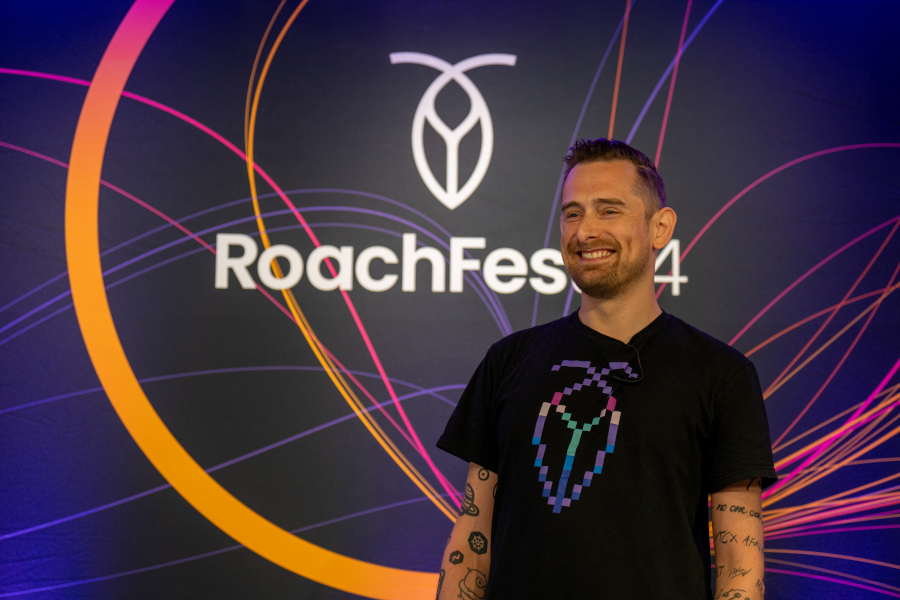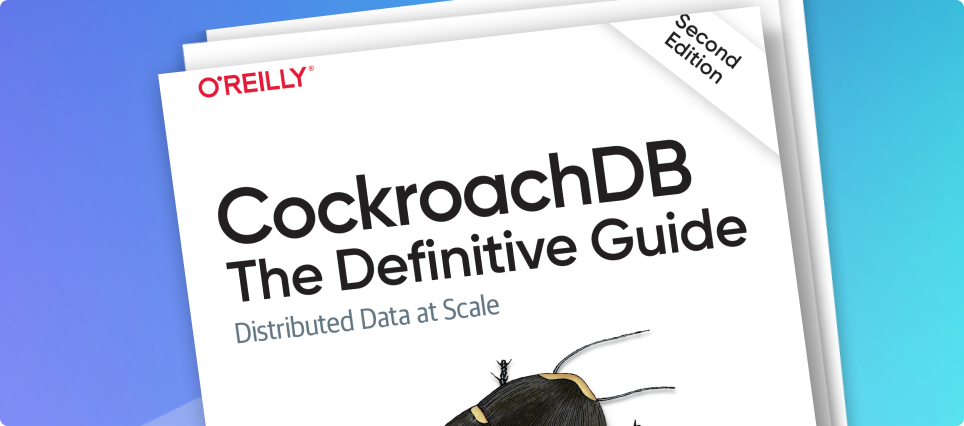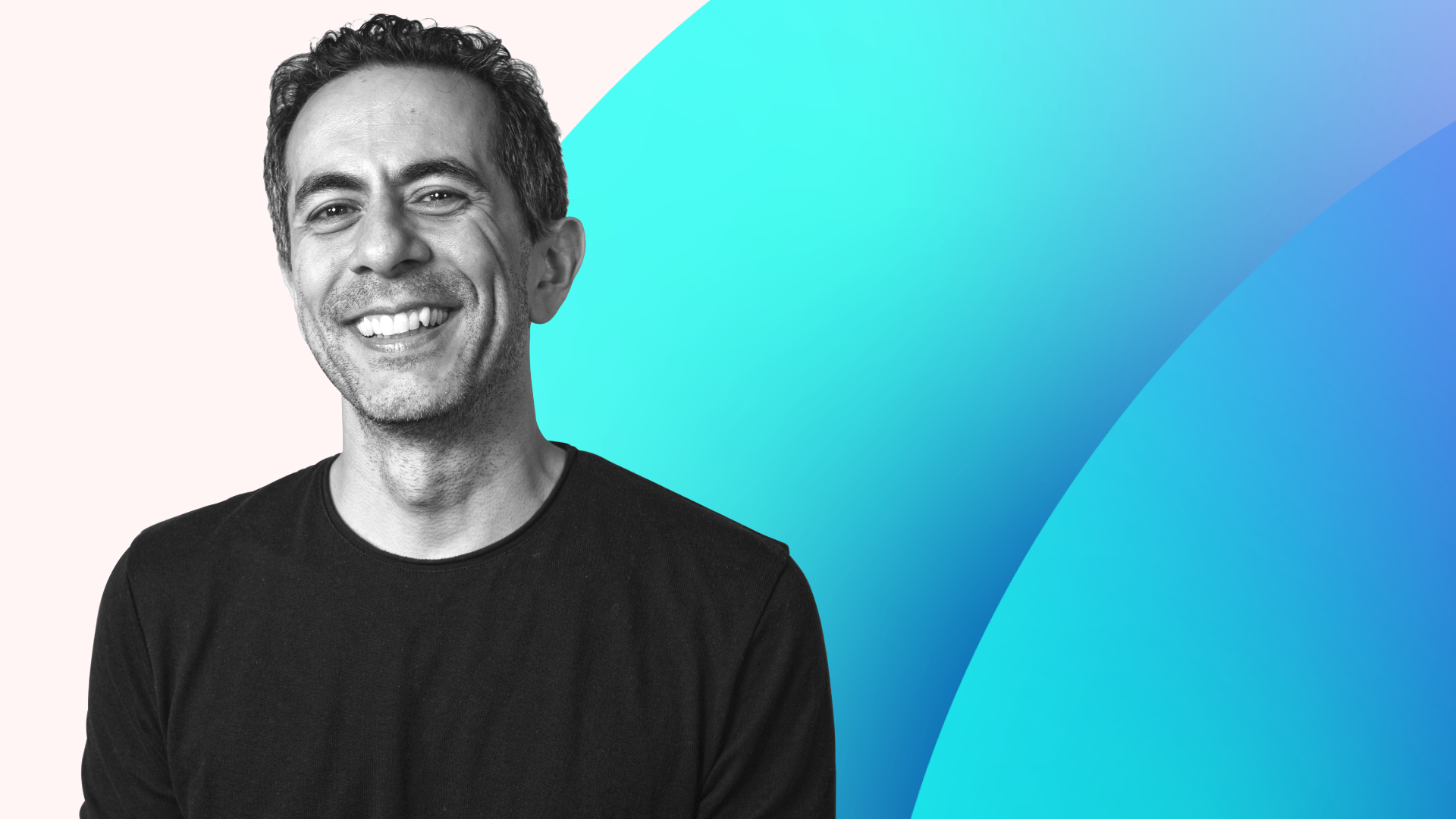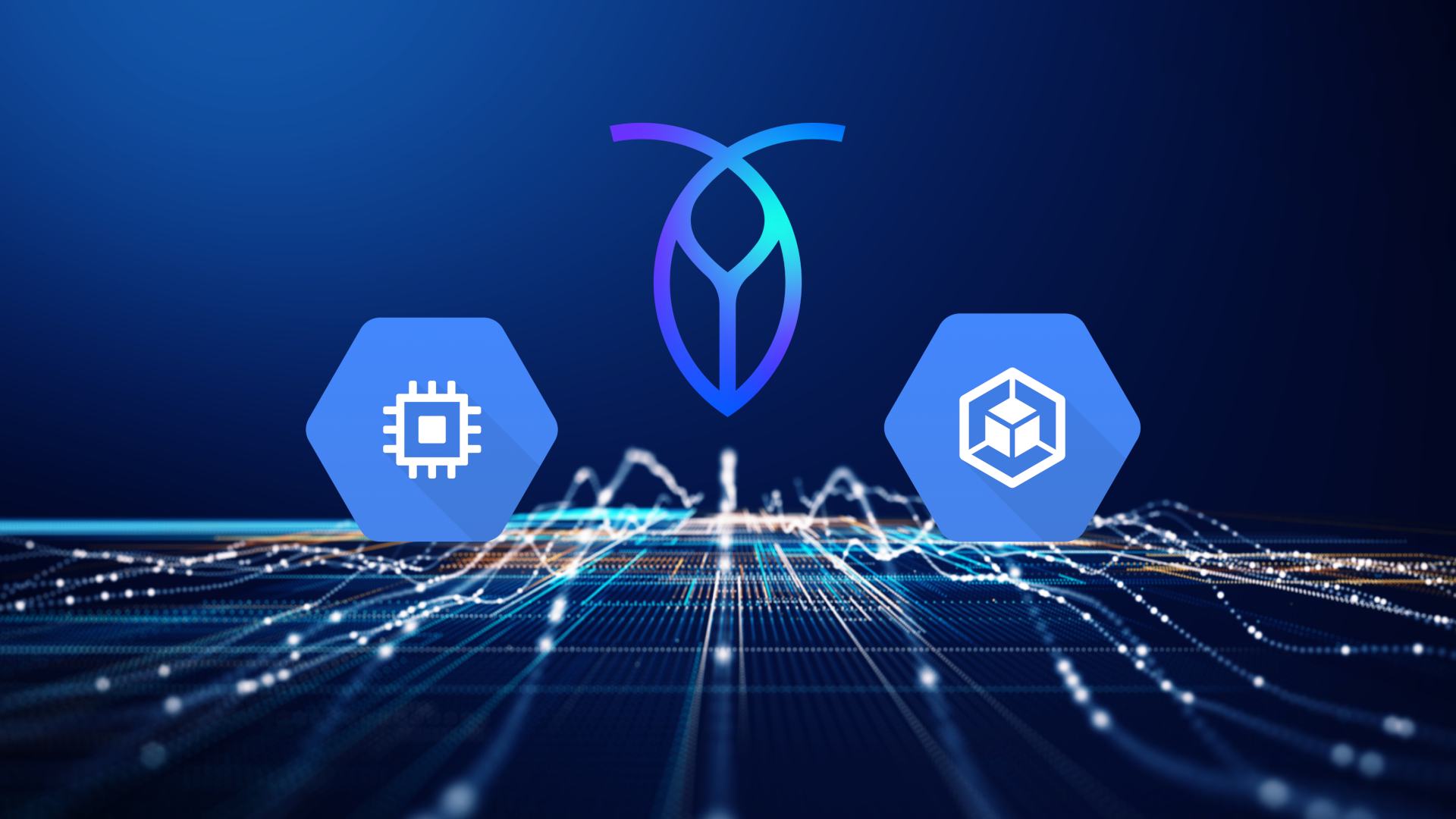Rob Reid in his office and YouTube filming studio, holding a copy of CockroachDB: The Definitive Guide, 2nd Edition (O'Reilly Media, 2025).
If you’ve perused our YouTube channel, you’ve probably seen Rob Reid, a London native, who sports not one, but TWO CockroachDB tattoos. If you attended RoachFest London 2024, then you were able to experience Rob’s infectious energy and passion for distributed SQL databases firsthand. Although Rob has become one of the many faces of Cockroach Labs, many don’t know that Rob started out as a customer.
Rob was a software developer for many years and encountered a number of databases throughout his career before stumbling upon CockroachDB in 2016. He created his first demo of CockroachDB in 2017 for a few colleagues, and became a customer soon after while leading engineering at a global cosmetics company.
Rob's tweet about his first CockroachDB tattoo, featuring our old logo.
After writing his own book on CockroachDB, Practical CockroachDB: Building Fault-Tolerant Distributed Systems (Apress, 2022), Rob was still not sick of us, and became a beloved member of the Cockroach Labs team. Today, one RoachFest London MC gig, dozens of webinars and events, and 116 YouTube videos (and counting) later, Rob is proud to have his name on another book: CockroachDB: The Definitive Guide, 2nd Edition (O’Reilly Media, 2025), which we are launching today!
The Cockroach Labs team first published our very own animal book with O’Reilly Media in 2022. Since then, a lot has changed. CockroachDB has evolved as a product, and the company has grown significantly.
I sat down with Rob to hear more about his story, why he’s so passionate about CockroachDB and distributed SQL, and what to expect in the 2nd edition.
How did you become passionate about software development?
// Rob's first C++ Program
#include <iostream>
int main() {
std::cout << "Hello Rob!";
return 0;
}I, like millions of others, was bitten by the bug of software development. I think you either love it or you hate it – it’s the same with everything. I wrote my first program probably back in 2001 – so a while back now.
It was a macro for Microsoft Word and I installed it on my school network’s machines. Whenever anyone closed Microsoft Word, the macro would open up two new instances of Word. So I would sit there just giggling to myself watching my code infuriate people. That was my first outing in code, and I was hooked.
The first programming language I ever picked up was C++, and I remember writing the canonical “Hello, World” program, and changing the code to print out “Hello, Rob” and I thought – “My god. The power!”
But the funny thing is that when you issue instructions to C++, you’re saying cin (c-in) for C input or cout (c-out) for C output, but I was reading them in my mind as “sin” and “coot” because I didn’t know how they were supposed to be pronounced!
So I issued a “coot” statement that said “Hello, Rob!”
EDITOR’S NOTE: According to Wikipedia, a coot is a “medium-sized water bird.” The more you know.
Can you share a bit about your software career?
So I can trace my entire career back to one conversation I had about two hours before a lecture. I’ve always arrived early everywhere because I have a terrible fear of being late to everything.
There was one other person in the lecture theater – “lecture hall” for the Americans – with me, and he was talking about this language that I hadn't really paid much attention to called C#. He told me, “I reckon this is going to be the business language of the future.” This guy was already working part-time as a C# developer, and I figured he knew something I didn’t, so I started learning C#.
But at the time everyone was teaching Java, a language I’ve never truly enjoyed writing. My university wouldn’t support me though, they told me I couldn’t study C#. So I just did everything that they were teaching in Java, but in C#.
Turns out, I’m really glad I listened to that guy. When all the companies came to our uni to advertise for job placements, they were all looking for C# developers. I was the only C# developer, and I had my pick among a lot of companies I wanted to work for.
I started out writing software to manage footage from body-worn video cameras (whose hardware I also had the chance to build) and the travel industry, before moving into finance, sports betting, telecoms, retail, aerospace, and finally, Cockroach Labs!
How did software development turn into technical evangelism?
Rob Reid serving as MC of RoachFest London '24.
I've known the Cockroach Labs team for a really long time. My evangelism journey of CockroachDB started in 2016. I gave my first demo of CockroachDB in 2017 to a bunch of colleagues at my then company and in 2018 I became a customer. I loved the product, and I knew that I was always going to end up at Cockroach Labs.
In terms of my journey to becoming a technical evangelist, it was really organic. Back when I was still a customer, I did my first two stage appearances talking about CockroachDB in Summer and Fall 2019.
I was blogging about CockroachDB feverishly back then, and I wrote my first book, The Practical Guide to CockroachDB in 2022 as a sort of thank you to the team. They had always been so good to me. After that book came out, I accepted an offer to work at Cockroach Labs as a technical evangelist.
As a developer, what made you fall in love with CockroachDB?
I’ve tried almost every kind of database in my career. I started out on Oracle, then Sybase, then SQL Server, and then MySQL (MariaDB) but I've also used Cassandra, MongoDB, Redis, Spanner, and practically all of the Cloud Service Provider databases. I’ve used them all, and CockroachDB has been the only database that I, as a developer, could set up on my laptop with very little effort. CockroachDB spoke to me as a developer: it doesn’t have to be hard. You can get an instance of the database running on your laptop so easily it feels like cheating.
For me, there have been some lines in the sand throughout the history of technology. In recent years, we’ve had Kubernetes, which changed the way we deploy software. Now, we have CockroachDB, which will change data forever. I got in so early – I was using CockroachDB before it was ready for production, and I've been riding the wave of it ever since, and enjoying every moment.
How did your video journey at Cockroach Labs start?
Check out Rob's latest video on operational resilience with CockroachDB:
Well I never expected to be one of the faces of the company. But I'm enormously proud that Cockroach Labs have entrusted me with that responsibility because it is a responsibility. In terms of YouTube, I was always a consumer of content. I’ve always liked YouTube, and thought it was going to be a strong place for CockroachDB. So I just bit the bullet.
When I joined, what I perceived to be of value was creating content like how-tos. I wanted to show people how CockroachDB worked rather than just telling them how great it was. I wanted them to see how great it was from themselves. Now I feel like a mouse that's selling cheese – it's the world's most well-designed, robust, resilient, and scalable cheese. I love the technology I’m helping to sell.
What was your goal in updating the book for the 2nd edition release?
The Definitive Guide was first published in May 2022, and we had just released v21.2. Since then, a lot about the product has changed in really great ways. CockroachDB is a lot more mature. It’s a lot more robust and resilient, and so many new features have arrived.
Just to name a few: we've got support for vectors enabling AI and ML workloads. We have super regions, the ability to domicile data for regulatory compliance, row-level TTL, functions, and stored procedures, the MOLT (Migrate Off Legacy Technology) suite, READ COMMITTED isolation, column level encryption, logical data replication (LDR), physical cluster replication (PCR), and our new Standard Tier for CockroachDB Cloud. We also closed many feature parity gaps with Postgres.
We needed the 2nd edition, and we’ll need the 3rd edition, and so on, because the team will keep innovating and advancing the product.
How did working on O’Reilly’s CockroachDB: The Definitive Guide differ from working on your first book, the Practical Guide?
For the Practical Guide, I was contacted by Apress, and I had never written a book before. But I saw it as a good opportunity to learn more. By that point, I'd known the Cockroach Labs team for years, and they’d been so good to me that I wanted to give something nice back. So, I've always seen The Practical Guide as a kind of thank you to Cockroach Labs.
With CockroachDB: The Definitive Guide, now I’m on the inside, working alongside the people who make it. I already knew all the features that I was writing about and I'd already demoed all of them before I wrote about them. But I’m just excited and happy that I was lucky enough to contribute again in another way to Cockroach Labs.
Was there a section that you were particularly proud or fond of?
Writing a book or updating one is a big undertaking and it always ends up being a bigger undertaking than you could possibly imagine to start off with. But I think the parts I'm most proud of are around architectural simplification. I got involved in a project last year on the topic and I decided that I wanted to bring that into the book somehow.
One of the learnings we took away with us from RoachFest back in 2023 was a strong theme of customers simplifying their architecture as a direct result of integrating CockroachDB into their systems. We heard firsthand from customers how CockroachDB was enabling the digital transformations and digital modernizations necessary to run their businesses today. You can’t transform your business with a monolithic architecture because you’re always working around a single point of failure.
For the 2nd edition, I brought in the concept of architectural simplification, and all the ways that CockroachDB can reduce infrastructure complexity for businesses. I think the book is a lot more relevant now than it was before thanks to new features like logical data replication and physical cluster replication. Not everyone can run CockroachDB in the way that it was originally intended (i.e. run across three or more machines or three or more physical locations). By including these topics, I hope that the book can show an even wider audience how CockroachDB can really serve their business needs.
Who is CockroachDB: The Definitive Guide for?
The Definitive Guide, and the Practical Guide, are the books that I wish I’d had when I first started using CockroachDB. I want developers, architects, operators, DBAs, to have confidence in CockroachDB. As they work with the product, they will realize that it looks and feels like Postgres. With all of the new pieces on architectural simplification, I’m hoping readers and users of CockroachDB will embrace it as a distributed SQL database, not just a Postgres replacement. You can use CockroachDB just like any other database, but bear in mind that with great power, comes great responsibility – and the book helps here.
As a developer myself, I’m biased, but I hope that developers and DBAs know that we understand their concerns about switching to a new database. I know, firsthand, that they need to keep the lights on. CockroachDB really is a database that does everything for them. And to career DBAs, it doesn’t diminish their value, it just changes the way they can think about a database. It becomes an ultra-resilient companion for them.
For architects, I’m hoping that they’ll get a better feel of how CockroachDB can integrate with their systems. You shouldn’t have to code around a database. With CockroachDB, you can throw data at it, using a ubiquitous database language and it handles the rest. The database becomes their company’s backbone.
What are your best tips for those just getting started with CockroachDB?
Think bigger than you’re currently thinking.
Yes, it looks like Postgres, but you should embrace the fact that it is a distributed database, because it’s a whole lot more powerful. Right now, a lot of people have to deploy a little database here, a little database there to solve their problems. All of these databases then need to be managed. With CockroachDB, it’s as simple as creating one database to serve your world. You can get the most out of CockroachDB (and your business) when you think bigger.
And get your hands dirty! It’s so easy to get started and once you try it, you’ll realize it’s a lot more familiar than you’d expect. And you can do that for free, with a CockroachDB Basic Cloud cluster. You can try globally distributed workloads. It’s a lot more flexible than anything you’ve used before.
Lastly, read our docs! I’ve been reading our docs since 2016, and they’ve always been some of the best docs I’ve ever read. Jesse Seldess, one of the original authors of CockroachDB: The Definitive Guide, was leading the docs team then, and it really was a labor of love. Now, Shannon Bradshaw and the docs team continue to be world-class.
Download CockroachDB: The Definitive Guide today
Over the last 10 years of distributed SQL innovation, Cockroach Labs has become a leading database company, powering business-critical use-cases at enterprises spanning financial services, eCommerce, SaaS, gaming, AI-driven applications, and more.
Learn to build and deploy applications with an elastic, distributed SQL database built for the cloud. Get practical guidance on building applications that scale elastically and provide low latencies, all while remaining highly available and essentially indestructible.
Get your free digital copy of CockroachDB: The Definitive Guide on our website today, or pre-order the eBook or paperback on Amazon.













